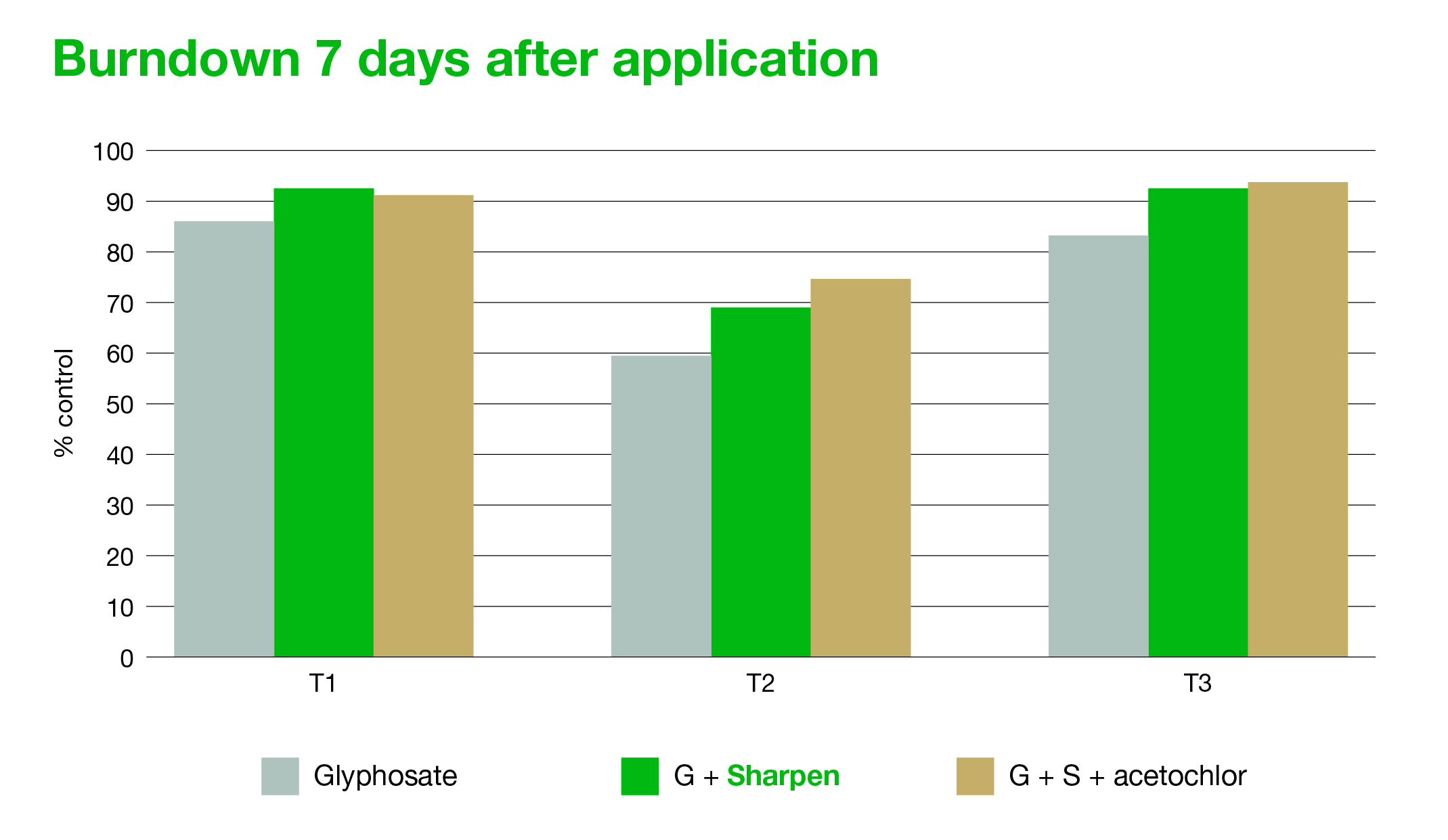Recent replicated trials have confirmed that Sharpen®, the only systemic Group 14 knockdown herbicide, can be successfully mixed with any glyphosate formulation to increase the speed and extend the spectrum of weed control when pastures are sprayed off.
Sharpen was first registered in New Zealand in 2011. Like all Group 14 herbicides, Sharpen is most effective on broadleaf weeds. But Sharpen has a key advantage over other products with the same mode of action: it has systemic activity within treated plants that can provide effective control of, for instance, atrazine-resistant fathen, through its movement down into the roots. Resistance management is strengthened through the addition of another mode of action into the tank.
Sharpen is regularly used to expand the activity of other knockdown herbicides such as glyphosate when spraying off pastures. Adding Sharpen to the tank broadens the spectrum of weeds controlled – ensuring excellent knockdown of mallow, fathen, dock, hawksbeard, nightshade, dandelion, willow weed and others – as well as speeding up the brown-out of treated pasture.
Of course, glyphosate needs no introduction: it’s been the standard knockdown herbicide since it first came to market as Roundup in the 1970s almost 50 years ago. It remains the standard, but there are now more than a dozen different formulations of glyphosate on the market, packaged as over 90 different products.
Herbicides cannot simply be randomly mixed together as some do not make great mixing partners. This may be due to physical mismatches or incompatibility in the way each one works. Compatibility issues are not always seen in every instance. The Australian label for Sharpen warns of possible incompatibility with glyphosate reducing the control of tropical C4 grasses, e.g. paspalum, but this has not been observed here and hence is not on the New Zealand label.
“We can’t really understand why anyone would think there was an issue when the two herbicides have been so widely used in a tank-mix over the last 10 years,” says BASF’s Senior Technical Services Specialist responsible for crop protection, Tim Herman. “Apparently there’s been a suggestion that adding Sharpen might possibly interfere with glyphosate’s activity against cool season grasses, namely ryegrass. It’s always hard to discredit rumours without hard data, so we decided to run trials looking for interference to confirm that there’s no such problem.”
We tested Sharpen at either 25 g/ha (knock down rate) or 150 g/ha (pre-emergence rate) in mixes with multiple glyphosate formulations (including 360 and 600 g a.i./L), two adjuvants (esterified canola oil and organosilicone), with or without acetochlor. Trials were conducted at three sites across New Zealand. The burndown of pasture (regardless of glyphosate formulation) was not disrupted by the addition of Sharpen (Fig 1) and the burndown of broadleaf weeds was faster (Fig 2). The only surviving plants in the picture below are untreated plots (Waikato trial).
Contractors can be confident of mixing Sharpen with any reputable glyphosate formulation for pasture burndown,” says Tim. “Adding Sharpen strengthens resistance management and achieves a better result in a faster timeframe. Given the demands on contractors’ time when there is pressure on to burn-off pastures and plant crops, this has to be a win-win for everyone.

Figure 1: Burn-down of pasture seven days after treatment with mixes of different glyphosate formulations with Sharpen and acetochlor
Pa01X1H: means from three replicated trials, T1 Waikato, T2 Bay of Plenty, T3 Canterbury, Nov/Dec 2021

Figure 2: Burn-down of broadleaf weeds seven days after treatment with mixes of different glyphosate formulations with Sharpen and acetochlor
Pa01X1H: means from three replicated trials, T1 Waikato, T2 Bay of Plenty, T3 Canterbury, Nov/Dec 2021
Tim’s only words of caution are that it’s essential to read and follow the label instructions for every agrichemical and check the plant-back intervals for every product in any tank-mix.
Footnote: Sharpen ACVM Approved: P00839
.
